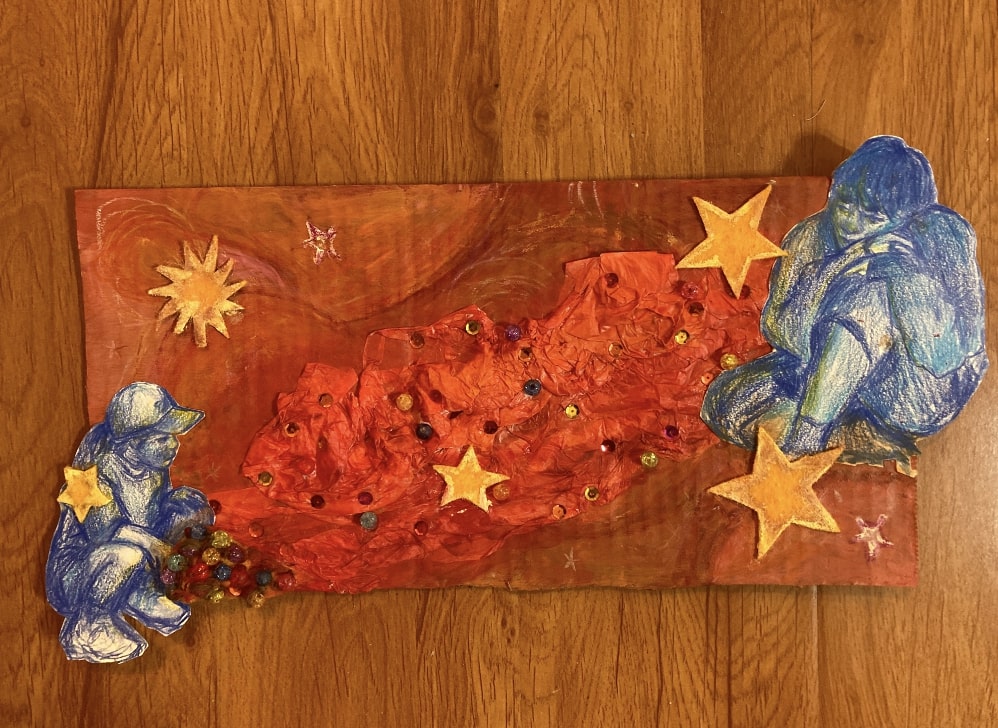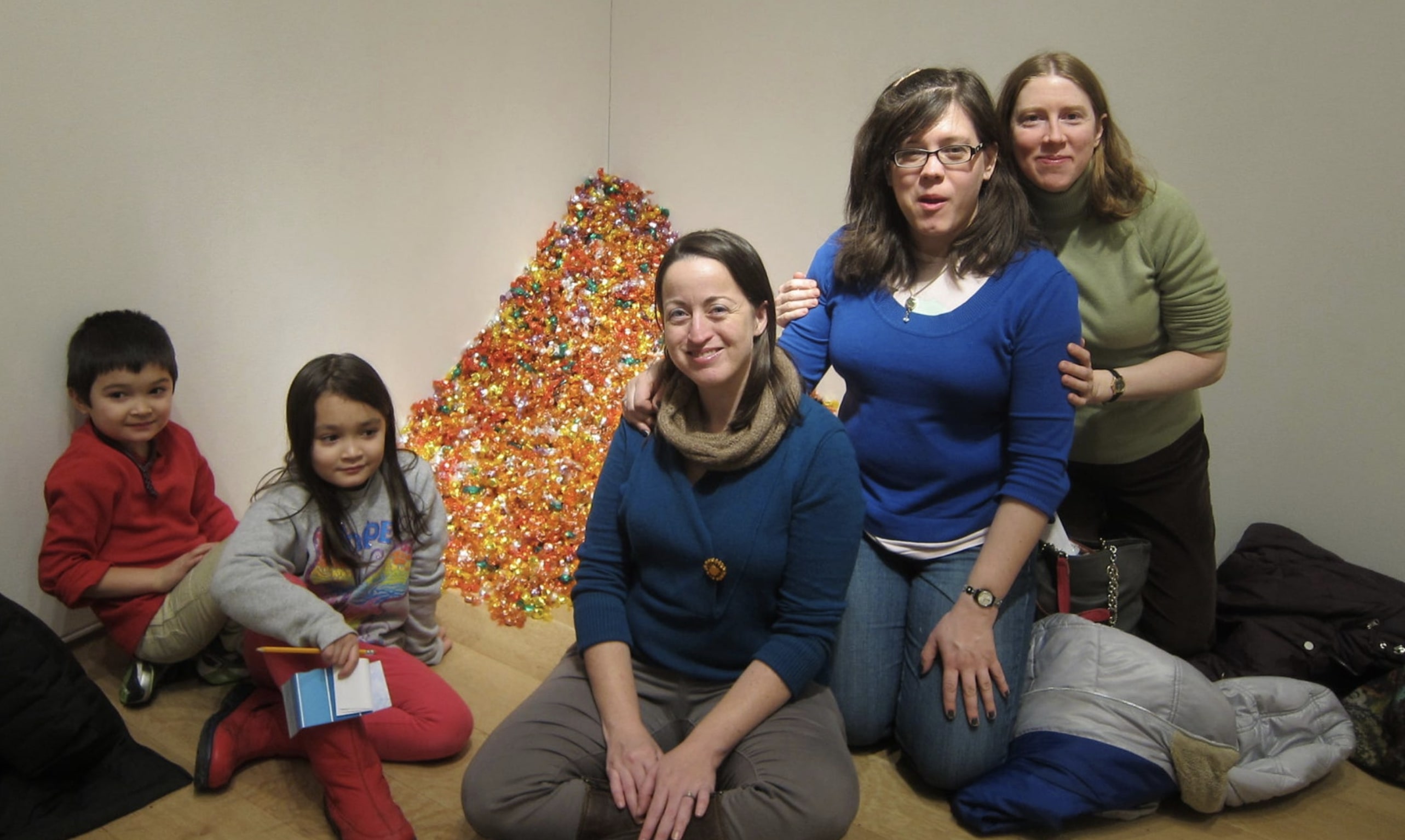Content Warnings: Death from disease, HIV/AIDS, queerphobia, frank discussions of disability, disordered eating
Hello!! I wanted to share my final art piece for the most recent unit, and a longer artist’s statement than I usually do.

This piece is a colorful self-portrait of myself about a decade ago next to myself now, but beyond that, it’s specifically a portrait of myself at the age I was when I visited Félix González-Torres’ famous piece, “Untitled” (Portrait of Ross in L.A.) with my mom (not pictured), a few of her friends, and my brother, and a partial portrait of the piece itself.

The exhibit is a pile of candy which corresponds to the weight of González-Torres’s partner Ross, who died of AIDS-related illness in 1991. As the exhibit remains, visitors are encouraged to take pieces of candy, representing Ross’s declining health.
I have only vague memories of visiting the exhibit, and was unaware of its significance at the time. Looking back, I am extremely lucky to have been able to see this piece. At the time I visited, I was unaware that I would grow up to later identify as both transgender and gay. I knew of the existence of queer people—my mom checked out books about Jazz Jennings from the library, the Unitarian Universalist church she taught youth services at was run by an openly gay minister who had two children with his husband, and one of my friends from around that time was raised by two moms—but I did not know I would identify as queer myself.
Similarly, I was unaware that I would be severely affected by a viral infection at the age of 14, causing me to develop several severe chronic illnesses, worsening the disabilities I already had, and forcing me to delay high school graduation and reduce my class schedule. I am no longer able to comfortably squat (as I am in the piece) or bend my back without being in severe pain. I am not able to leave the house beyond walking to the mailbox, even using mobility aids, without being largely bedbound and completely fatigued for days afterwards. I’m not going to list my whole experiences with sudden disability and the intense and painful grief that surrounds it for me, but in short, it changes the way that I look both at my younger self and at the pile of candy I saw in 2013.
I know this is not the thing that transmasculine people are expected to (or “supposed to”) say, but I did not dislike being a little girl. I feel no apathy towards my younger self. I cannot hate her. I miss having the body of someone who could dance barefoot in a park, or hop from rock to rock in a creek. However, while this may come as a surprise to some people, becoming disabled has actually made me feel a lot more affection for my body than I used to.
When I came out in the late spring of 2021 as transmasculine, I asked around if anyone would be willing to purchase a chest binder for me, with the promise of paying them back. One of my good friends, Milli, bought me one, refusing to accept compensation. That fall, I started the school year wearing it relatively often, while still being cognizant of my hypermobility and asthma. When I became sick, the slight discomfort of wearing a binder quickly changed to severe asthma attacks and my vision blacking out after only five to ten minutes of having the garment on.
I have been unable to wear a binder since, and stopped wearing bras entirely last summer due to my severe back pain. While this obviously sucks because I like to play with my gender presentation, it’s also forced me to accept the way that my body looks and has alleviated a lot of my struggles with gender dysphoria. Similarly, in middle school, I struggled with disordered eating patterns, but I’m okay with the fact that I weigh more than I used to because I’m unable to exercise much due to my health. I actually like having a soft abdomen, and have a much healthier relationship with food now! Although I would likely choose to have my health back given the choice, I love that my disabilites have forced me to accept true body neutrality and have forced me into acceptance of my condition at any given moment and my limitations.
All of this is to say: I wish that I could sit down with the little girl in that picture, who is seeing a piece of art about the body of a gay man degrading due to a virus, and tell her that she will one day be a gay man whose body has suffered deeply from viral infection, and that she will love her body nonetheless, and trace its path through time with a mixture of joy and grief, and that she will be lucky to have the privilege to do so. In a time when those in power are trying to silence people who just want to live comfortably in our own skin and have agency over their own lives and lovers, she will view her transness with the same fondness with which she views warm sunbeams and distant stars, and she will love her body through all its changes and struggles.
This piece is a path forged through time to my younger self, from an older version of her with calves swollen from chronic blood pooling, who is sitting down because standing for too long makes him dizzy, who views her with nothing but adoration and affection despite how others tell him he should feel, who refuses to view life as a transgender gay man with anything but stars in his eyes. There is so much joy to be found in even the lives of those others respond to with pity.
I hope you enjoyed this piece, and reading about it! If you would like to support the fight for transgender liberation, you can donate to the Transgender Law Project here.